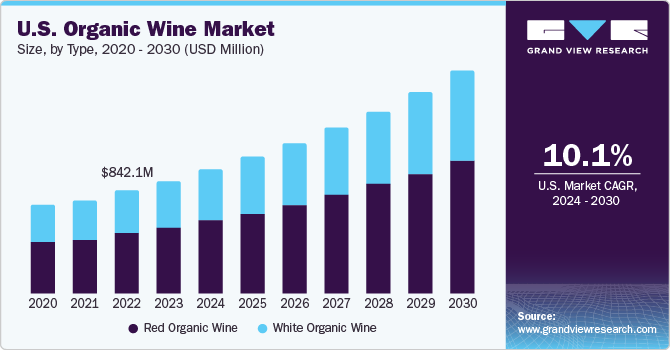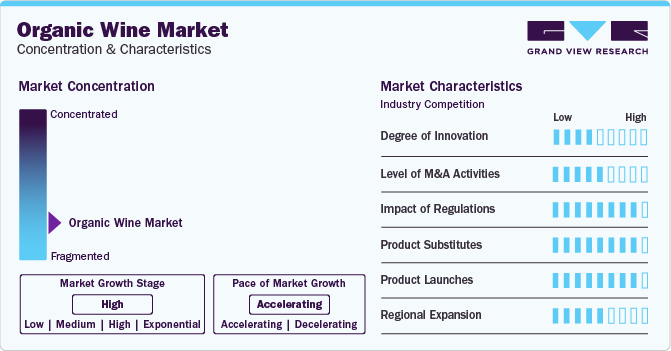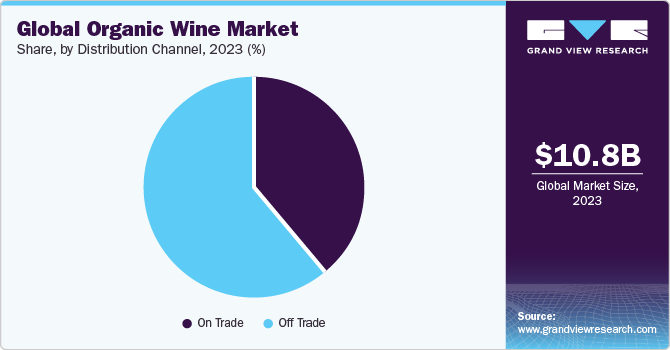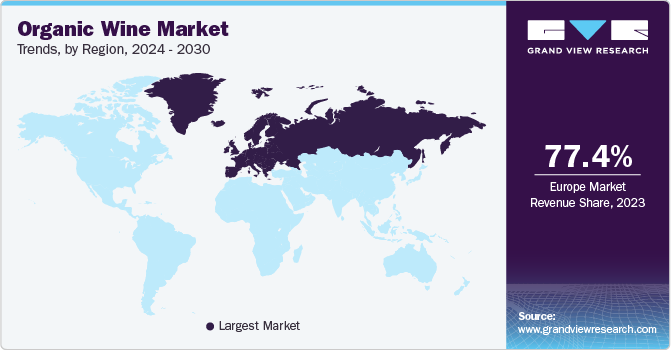
Organic Wine Market Size, Share & Trends Analysis Report By Type (Red, White), By Packaging (Bottles, Cans, Others), By Distribution Channel (On Trade, Off Trade), By Region, And Segment Forecasts, 2024 - 2030
- Report ID: GVR-4-68039-914-8
- Number of Report Pages: 120
- Format: PDF, Horizon Databook
- Historical Range: 2018 - 2023
- Forecast Period: 2024 - 2030
- Industry: Consumer Goods
Organic Wine Market Size & Trends
The global organic wine market size was estimated at USD 10.80 billion in 2023 and is expected to grow at a CAGR of 10.4% from 2024 to 2030. The organic wine category has been growing for several years; however, as consumers have become more concerned about what they eat and drink, there is a sense of acceleration within the category. The market will continue to grow strongly, backed by organic wine consumption figures, which doubled in the last five years. According to the figures published by the Beverage Daily in September 2021, global organic wine consumption doubled from 349 million bottles in 2012 to 676 million bottles in 2017. These numbers are expected to increase as consumers gradually shift toward organic options in wine.

Consumers are becoming more mindful of what they consume, seeking products that align with their health and wellness goals. In the context of the organic wine market, this health-conscious mindset is a key driver for the rising demand. Organic wines are perceived as a healthier alternative due to the specific cultivation practices involved in their production.
The product is expected to gain further traction as large and small vineries switch to more sustainable winemaking, and retailers stock a larger range of organic wines to meet rising consumer demand. Cono Sur, a prominent organic wine brand launched a range of organic wines, comprising a Pinot Noir, Sauvignon Blanc, Chardonnay, red blend, and a Malbec in the year 2020, owing to the growing demand from consumers in the UK
In recent years, growing concerns about health and environmental issues have led to an increased demand for organic wines. As per an article published by the Beverage Daily in September 2021, Europe is by far the largest producer of organic wine, accounting for 90% of the global wine-growing organic area. The countries-France, Italy, and Spain-make up to 79% of all organic wine together.
According to the Organic Trade Association (OTA), 75 million millennials in America are consuming organic food and drinks. Consumers in the age group 18 to 34 years are the dominant organic buyers in the U.S. In addition, according to the OTA, organic food sales surpassed USD 56 billion in 2020, 12.8% up from the previous year’s sales. This growth of organic products is expected to drive the growth of organic wine market globally.
A survey commissioned by ProWein, the German wine trade show, indicates a growing consumer interest in organic wine with a promising outlook. Conducted by Geisenheim University, almost 3,000 experts were surveyed within the wine supply chain across 48 countries at the close of 2021. The findings reveal an optimistic sentiment, with a substantial majority of specialist wine dealers (78%), hoteliers (77%), and food service providers (72%) expressing that organic wine production would continue to rise in the future.
Market Concentration & Characteristics
The organic wine market has witnessed a notable degree of innovation in recent years, driven by evolving consumer preferences towards healthier and more sustainable products. One key aspect of this innovation lies in the cultivation and production methods employed by organic wine producers.

Unlike conventional vineyards that rely heavily on synthetic pesticides and fertilizers, organic wine producers prioritize natural and organic practices, such as composting, cover cropping, and the use of beneficial insects, to nurture vine health and manage pests and diseases. This shift towards organic farming not only aligns with consumers' increasing demand for eco-friendly products but also contributes to biodiversity conservation and soil health, thus representing a significant innovation within the wine industry.
The growing consumer demand for organic and sustainable products has attracted interest from both established wine producers seeking to expand their portfolios and investors looking to capitalize on the market's growth potential. M&A transactions in the organic wine sector often involve acquisitions of smaller, independent organic wineries by larger conglomerates or strategic partnerships between organic and conventional wine producers. These transactions enable organic wine brands to access broader distribution networks, scale up production, and benefit from the resources and expertise of larger parent companies, while also providing financial returns for founders and investors.
Type Insights
The red organic wine market segment held a revenue share of 61.7% in 2023. Red wines, including organic red wines, contain high amounts of resveratrol, a powerful antioxidant that helps fight free radicals and toxins that may damage cells and organs. In addition, resveratrol in red wines promotes health and longevity. The consumption of organic red wines has been shown to aid brain health and prevent memory decline and other related conditions, such as dementia and Alzheimer’s.
In September 2022, Miller Family Wine Company launched Reciprocity, a new organic wine brand. In April 2022, Winc, Inc., a platform for alcoholic beverage brands, expanded its offerings by launching Wonders-a no-sugar, organic, sustainable wine. The brand will be made available on Winc.com, and the product range includes red wine and rosé variants.
The white organic wine market segment is expected to witness a CAGR of 9.9% over the period of 2024 to 2030. Organic white wines are high in minerals, such as zinc, which boosts metabolic function. The content of antioxidants and polyphenols, which improve cardiovascular function, is higher in organic white wine than in red wine. Moreover, flavonoids are found in white wine. These help reduce inflammation of the airways and protect the lungs, boosting their functioning. Owing to such factors, the consumption of white wine is increasing.
Moreover, players operating in the industry are increasingly launching new products. For instance, in June 2023, Bodega Argento launched ‘Artesano Organic White Malbec’, the first-ever White Malbec in the U.S., which is produced using organic grapes.
Packaging Insights
The bottled organic wine market segment held the largest revenue share of 91.3% in 2023. Glass bottles are the primary packaging format for organic wines as they are recyclable and reusable. Due to the material’s inert nature, glass bottles can store wine for a long time compared to plastic bottles and cans. Moreover, glass gives the packaging a premium look, which is another factor attributable to the demand for this packaging. Glass is the most adopted packaging material for organic wines.
In February 2021, New Zealand-based estate Villa Maria launched its organic wine range-EarthGarden-in the UK The product range includes a Marlborough Sauvignon Blanc 2020, Marlborough Pinot Noir 2019, Hawke’s Bay Rosé 2020, and Hawke’s Bay Merlot/Cabernet Sauvignon 2019. The 100% BioGro-certified range is packaged in recycled glass bottles.
The canned organic wine market segment is expected to witness a CAGR of 14.2% from 2024 to 2030. Aluminum and steel cans are extensively used for the packaging of organic wine. Cans are more convenient and portable than bottles, which, in turn, is driving the growth of canned wines. Aluminum cans weigh less than glass bottles and therefore lessen the carbon footprint of transporting them from the vineyard to the distributors. The demand for environmentally friendly packaging is rising among consumers.
As a result, new product launches in canned formats are likely to gain traction among consumers globally. For instance, in December 2023, Vinca, a canned wine company based in the UK, launched a range of organic wine in Ardagh Metal Packaging’s aluminum cans. This newly launched range of organic wines is available in single-serve cans of 187 ml. Moreover, in January 2021, Defy, a UK-based wine company, launched an organic Italian white wine in a 250 ml can. The product is available nationwide in the UK.
Distribution Channel Insights
In 2023, sales of organic wine through off-trade channels accounted for 61.1% of the total market share. The off-trade distribution channel of organic wine includes supermarkets, hypermarkets, retail outlets, organic stores, and e-commerce platforms. According to the 2020 Drink Analysis report by International Wine & Spirit Research (IWSR), around 80% of alcohol sales in the U.S. were generated from the off-trade sales channel.
Retailers offer a diverse wine selection and products with discounts and offers. They also provide a convenient one-stop shop for wine consumers. The demand for organic products is increasing among consumers. As a result, organic wine retailers are expanding their offerings to cater to various consumer preferences. In August 2023, Majestic, a UK-based wine retailer, expanded its organic wine offerings from 50 to 67 to meet the growing demand. Consumer inclination toward e-commerce is also expected to continue over the forecast period and drive segmental growth.

The online distribution of organic wine has emerged as a significant channel for reaching consumers who seek convenient access to a wide selection of sustainably produced wines. This trend reflects broader shifts in consumer behavior towards online shopping and the increasing demand for organic and environmentally friendly products. The online distribution of organic wine offers several advantages for both consumers and producers, contributing to the growth and accessibility of the organic wine market.
Distribution of organic wine through on-trade channels is expected to grow at a CAGR of 9.6% from 2024 to 2030. The on-trade distribution channel includes bars, clubs, restaurants, hotels, and wineries. Product penetration of organic wine through restaurants and bars is the key factor driving the segment’s growth. For instance, in London, organic wine, including red, white, and rosé, is available in wine bars and restaurants such as Typing Room, Antidote Wine Bar, The Laughing Heart, and Terroirs.
Regional Insights
The North America organic wine market is expected to grow at a CAGR of 10.2% from 2024 to 2030. The region has experienced significant growth and evolution in recent years, driven by rising consumer preference for healthier and more sustainable products. As consumers become increasingly conscious of the environmental and health impacts of their purchasing decisions, the demand for organic wine has surged across the region. This trend is particularly pronounced in countries like the U.S. and Canada, where organic food and beverage consumption has become mainstream.

One of the key factors fueling the growth of the North America market is the rising awareness of the benefits associated with organic farming practices. Consumers are increasingly drawn to organic wines due to their perceived health benefits, which stem from the absence of synthetic pesticides, herbicides, and fertilizers in the cultivation process. Additionally, organic wine production aligns with broader sustainability concerns, such as biodiversity conservation, soil health, and water conservation, resonating with environmentally conscious consumers.
U.S. Organic Wine Market Trends
The organic wine market in the U.S. is expected to grow with a CAGR of 10.1% from 2024 to 2030. U.S. market for organic wines has benefited from a supportive regulatory environment and robust certification programs. The United States Department of Agriculture (USDA) oversees the National Organic Program (NOP), which establishes standards for organic agricultural practices, including wine production. Wineries that adhere to these standards can obtain USDA Organic certification, providing consumers with assurance of the organic integrity of the wine.
In addition to regulatory support, the U.S. organic wines market has seen significant investment and innovation from both established wine producers and boutique wineries. Large wine companies have recognized the potential of the organic market and have acquired organic vineyards or converted existing vineyards to organic practices. At the same time, smaller, artisanal producers are leveraging organic and biodynamic farming techniques to differentiate their wines and appeal to niche consumer segments.
Europe Organic Wine Market Trends
In 2023, the organic wine market in Europe accounted for a revenue share of 77.4%. European wine-producing regions, such as France, Italy, Spain, and Germany, have been at the forefront of the organic wine movement. These countries boast centuries-old vineyards and a deep-rooted culture of winemaking, making them ideal environments for organic viticulture. Many wineries in these regions have transitioned to organic farming practices, focusing on soil health, biodiversity, and the preservation of traditional grape varieties.
In addition to a strong foundation of organic vineyards, the Europe organic wines market benefits from robust regulatory frameworks and certification programs. The European Union's organic regulations, which set strict standards for organic agriculture and food production, provide consumers with confidence in the authenticity and integrity of organic wine products. Wineries that meet these standards can label their wines as "organic" or display the EU organic logo, enhancing transparency and trust in the market.
Key Organic Wine Company Insights
The market players offer a wide range of red and white organic wines such as Pinot Noir, Cabernet Sauvignon, and Chardonnay. The competition among players is based on numerous parameters including quality, product offerings, innovation, corporate reputation, and price. New product launches, innovation, geographical expansion, distribution networks, and mergers & acquisitions are some of the key strategies players adopt to strengthen their position in the market and gain a higher market share.
The players face intense competition, especially from top producers of organic wines, as they have a larger customer base. Strong brand recognition and vast distribution networks also intensify rivalry among companies. Market players have been implementing various expansion strategies, including partnerships and product launches, to grow in the market. Avondale, Kendall-Jackson, and The Organic Wine Company are some of the leading players in the organic wine market.
-
Avondale has a global outreach with distribution centers in countries such as Brazil, France, Canada, Finland, Germany, Indonesia, Belgium, Hungary, Ireland, Norway, Sri Lanka, and Sweden. Avondale’s wine cellar has a capacity of 500 tons with a gravity-flow facility that ensures the grapes are moved with the minimum mechanical intervention.
-
Kendall-Jackson has a large product portfolio of wines such as Stature, Jackson Estate, Grand Reserve, Vintner’s Reserve, and K-J Avant. The wine categories include sauvignon blanc, pinot gris, chardonnay, other whites, rosé, pinot noir, merlot, cabernet sauvignon, and syrah.
-
The Organic Wine Company’s organic vineyards are certified by ECOCERT, one of the French certification associations with standards focusing on the type of materials, quantities, and procedures used in growing grapes and making wine organically.
Key Organic Wine Companies:
The following are the leading companies in the organic wine market. These companies collectively hold the largest market share and dictate industry trends.
- Bonny Doon Vineyard
- Ferrari-Carano
- Domaine Leroy
- Giuseppe Quintarell
- Willamette Valley Vineyards
- Grover Zampa Vineyards
- Stellar Organics
- The Organic Wine Works
- Concha y Toro
- Treasury Wine Estates
Recent Developments
-
In August 2023, Line 39 Wines, a prominent premium wine brand and Certified B Corporation expanded its portfolio to cater to the growing Better for You category. The latest addition, Line 39 Organic, is a venture by winemaker Alyssa Reynolds and features three new wines sourced from California Certified Organic Farmers (CCOF): a 2022 Cabernet Sauvignon, Chardonnay, and Rosé. Line 39 Organic wines prioritize a low-intervention approach to winemaking, omitting pesticides to create a delicious and fruit-forward selection.
-
In June 2023, Jackson Family Wines expanded into the English wine industry. The company has purchased a large volume of 2022 base wine from Kent and Sussex and plans to produce high-quality sparkling wine at a contract winemaking facility. The company is also in the process of acquiring land in the Crouch Valley to plant Chardonnay and Pinot Noir vines for still and sparkling wines.
-
In November 2022, King Estate Winery, one of the major wine producers in Oregon, acquired Pfeiffer Winery and Vineyards, a 70-acre operation near Junction City and a long-time vineyard partner. This acquisition aligns with a larger trend, as the Oregon wine industry has experienced a notable increase in mergers and acquisitions over the past few years.
-
In May 2022, Avondale partnered with PiWOSA as its 12th member. PiWOSA - Premium Independent Wineries of South Africa, are independent wine producers focused on promoting premium South African wines on the international stage. Global roadshows and the execution of innovative marketing programs are some of the activities that Avondale will be incorporating as part of PiWOSA.
Organic Wine Market Report Scope
|
Report Attribute |
Details |
|
Market size value in 2024 |
USD 11.87 billion |
|
Revenue forecast in 2030 |
USD 21.48 billion |
|
Growth rate |
CAGR of 10.4% from 2024 to 2030 |
|
Actuals |
2018 - 2023 |
|
Forecast period |
2024 - 2030 |
|
Report updated |
June 2024 |
|
Quantitative units |
Revenue in USD million/billion and CAGR from 2024 to 2030 |
|
Report coverage |
Revenue forecast, company ranking, competitive landscape, growth factors, and trends |
|
Segments covered |
Type, packaging, distribution channel, region |
|
Regional scope |
North America; Europe; Asia Pacific; Central & South America; Middle East & Africa |
|
Country scope |
U.S.; Canada; Mexico; UK; Germany; France; Spain; Italy; China; Japan; South Korea; Australia & New Zealand; India; Brazil; South Africa |
|
Key companies profiled |
Bonny Doon Vineyard; Ferrari-Carano; Domaine Leroy; Giuseppe Quintarell; Willamette Valley Vineyards; Grover Zampa Vineyards; Stellar Organics; The Organic Wine Works; Concha y Toro; Treasury Wine Estates |
|
Customization scope |
Free report customization (equivalent up to 8 analysts working days) with purchase. Addition or alteration to country, regional & segment scope. |
|
Pricing and purchase options |
Avail customized purchase options to meet your exact research needs. Explore purchase options. |
Global Organic Wine Market Report Segmentation
This report forecasts revenue growth at the global, regional, and country levels and provides an analysis of the latest industry trends and opportunities in each of the sub-segments from 2018 to 2030. For the purpose of this study, Grand View Research has segmented the global organic wine market report based on type, packaging, distribution channel, and region:

-
Type Outlook (Revenue, USD Million, 2018 - 2030)
-
Red Organic Wine
-
White Organic Wine
-
-
Packaging Outlook (Revenue, USD Million, 2018 - 2030)
-
Bottles
-
Cans
-
Others
-
-
Distribution Channel Outlook (Revenue, USD Million, 2018 - 2030)
-
On Trade
-
Off Trade
-
-
Regional Outlook (Revenue, USD Million, 2018 - 2030)
-
North America
-
U.S.
-
Canada
-
Mexico
-
-
Europe
-
UK
-
France
-
Germany
-
Spain
-
Italy
-
-
Asia Pacific
-
China
-
Japan
-
Australia & New Zealand
-
South Korea
-
India
-
-
Central & South America
-
Brazil
-
-
Middle East & Africa
-
South Africa
-
-
Frequently Asked Questions About This Report
b. The global organic wine market size was estimated at USD 10.80 billion in 2023 and is expected to reach USD 11.87 billion in 2024.
b. The global organic wine market is expected to grow at a compounded growth rate of 10.4% from 2024 to 2030 to reach USD 21.48 billion by 2030.
b. In 2023, the organic wine market in Europe captured a revenue share of 77.4%. European wine-producing regions, such as France, Italy, Spain, and Germany, have been at the forefront of the organic wine movement. These countries boast centuries-old vineyards and a deep-rooted culture of winemaking, making them ideal environments for organic viticulture. Many wineries in these regions have transitioned to organic farming practices, focusing on soil health, biodiversity, and the preservation of traditional grape varieties.
b. Some key players operating in the organic wine market include Avondale, Elgin Ridge Wines, Kendall-Jackon Winery, The Organic Wine Company, Bronco Wine Company, King Estate Winery, Grgich Hills Estate, Emiliana Organic Vineyards, Societa Agricola Querciabella SpA, Frey Vineyards
b. Consumers are becoming more mindful of what they consume, seeking products that align with their health and wellness goals. In the context of the organic wine market, this health-conscious mindset is a key driver for the rising demand. Organic wines are perceived as a healthier alternative due to the specific cultivation practices involved in their production.
We are committed towards customer satisfaction, and quality service.
"The quality of research they have done for us has been excellent."




